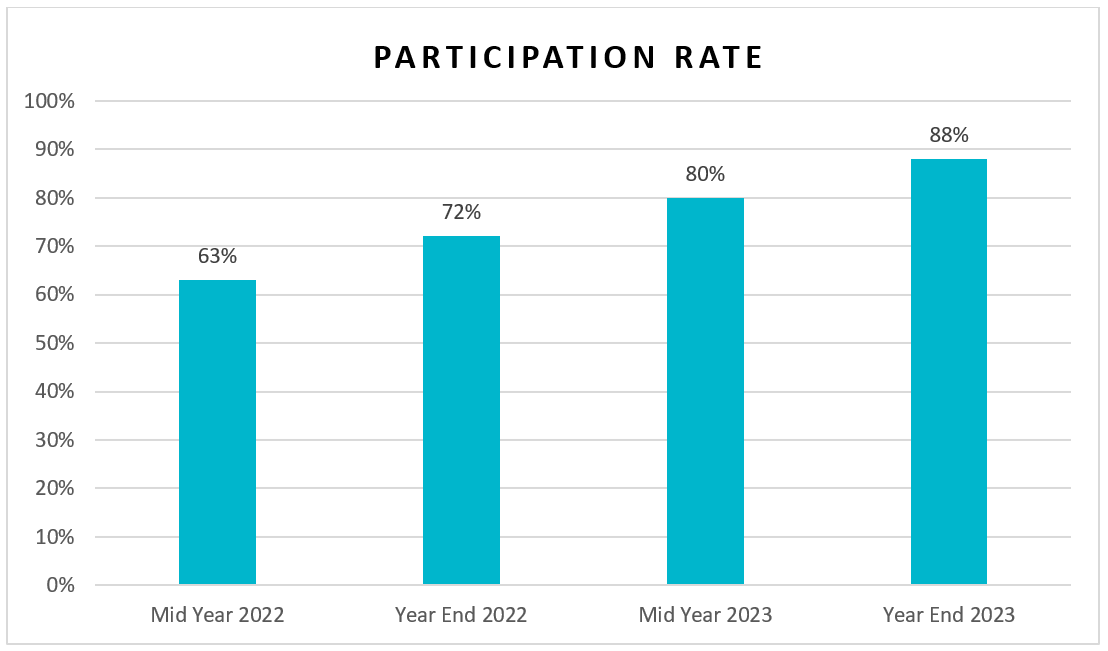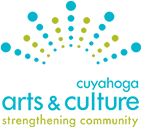Each year, CAC collects reports from our General Operating Support (GOS) grantees, which include a variety of questions about their operations, programming, and financial health. We pulled together that data to take a comprehensive look at where CAC’s GOS grantees stand at the end of the 2023 grant year.
Despite the persistent challenges posed by the Covid-19 pandemic, GOS grantees have shown resilience, adaptability, and a commitment to their missions. By identifying trends across this cohort, we hope to provide a helpful look at the state of our region’s arts and cultural nonprofits.
CAC’s General Operating Support
Number of grantees: 68
Approximate annual unrestricted revenue range: $105k-$46.5m
Audience/Visitor Participation & the Revenue Gap
One of the crucial metrics examined in the GOS 2023 report is the audience/visitor participation level compared to pre-pandemic levels, which continues to increase steadily. At year-end 2023 the rate of audience participation was reported at 88% of pre-pandemic levels. Public program offerings by organizations have reached 91% of pre-pandemic levels, indicating a substantial recovery in organizational capacity, and a matching of the audience market/demand.

If audience participation continues at this rate, it could return to pre-pandemic levels by year-end 2024.
However, there remains a significant revenue gap, with 48% of grantees experiencing financial challenges. This figure, slightly higher than mid-year 2023, underscores the persistent economic strains faced by arts and cultural organizations. Of those experiencing revenue shortfalls, 45% believe these changes are permanent, highlighting the need for innovative strategies to navigate the evolving financial landscape.
Operational Changes and Adaptations
The GOS 2023 reports shed light on the permanent changes observed in organizations' operations and public programming, as a result of the pandemic. Several common themes emerged around these adaptations that are becoming part of the “new normal”:
- Virtual Programming: Many organizations have successfully embraced virtual offerings, expanding their reach and engaging wider audiences beyond geographical constraints.
- Shifts in Audience Engagement: Organizations are reimagining their approaches to audience engagement, with a focus on grassroots-level initiatives, evolving marketing strategies, and understanding post-COVID audience behaviors.
- Financial Challenges and Strategies: Decreased funding, donor fatigue, and shifting priorities have posed significant financial challenges. Strategies such as increased philanthropy efforts, diversification of revenue streams, and prudent budget management are being employed to address these challenges.
- Programmatic Partnerships: Collaborations and partnerships have emerged as vital strategies for sustaining and expanding organizational reach, fostering synergies, and maximizing impact.
- Staffing and Compensation Adjustments: The pandemic has necessitated adjustments in staffing, including changes in work arrangements and efforts to retain and fairly compensate staff amidst heightened competition.
Demographic Data Collection: Practices and Concerns
Two thirds of CAC’s grantee organizations collect self-reported demographic data from their staff and board. With many grantee organizations setting explicit goals around increasing diversity on their staff and boards, this is an important tool toward understanding how organizations change over time.
In the last year, organizations who both collect demographic data and share it publicly via their GuideStar/Candid profile doubled from 8 to 15%.
Concerns and Questions: When it comes to integrating a practice of collecting demographic data from staff and board, some organizations expressed concerns about privacy, incomplete participation, and the potential risks of publicly reporting demographic data. Guidance and support are sought to navigate these challenges effectively.
GOS Grantees Support Artists
CAC, by law, can only fund nonprofit organizations. However, we recognize the important role artists play in our creative economy. In total, 43% of GOS grantees indicate that they provide funding/support for artists as part of their mission driven work through the following ways:
- Monetary Support: Some organizations offer unrestricted monetary support, ranging from salaries for staff artists to cash support for artist-led projects.
- Specific Project Support: Many organizations provide funding for specific projects or opportunities such as fellowships, commissions, residencies, and exhibitions.
- Physical Spaces: Several organizations offer physical spaces for artists to work, rehearse, or exhibit their work, including studio space, gallery space, or access to facilities for artmaking.
- Institutional Connections: Some organizations facilitate connections between artists and other institutions or professionals. This may include networking events, introductions, or partnerships with other arts organizations.
- Professional Development: Many organizations offer professional development opportunities for artists, such as workshops, training programs, consultations, and mentorship. These programs aim to support artists in developing their skills and advancing their careers.
- Other Forms of Support: Additional forms of support include providing resources, materials, advocacy, fiscal sponsorship, and hosting performances or events.
Strategic Plans
Strategic planning remains a cornerstone for organizational resilience and growth, with 78% of grantees having current strategic plans. 62% of the goals submitted to CAC for 2024 as part of reporting were directly informed by these strategic frameworks, which indicates to CAC staff that the organizations receiving General Operating Support continue to meet CAC’s goals through their mission driven work.
Looking Ahead
We hope it is helpful to see how your organization compares to the GOS cohort as a whole, and what your peers are thinking and sharing. For CAC, this snapshot of the arts and culture sector is a useful tool as we plan for the future of our grant programs. Thank you to all the organizations who submitted data to contribute to this report.
If you’d like to learn more, please contact your grant manager or info@cacgrants.org.

About the author
CAC Staff